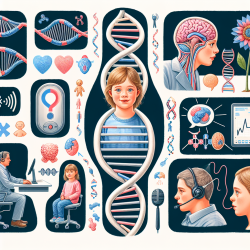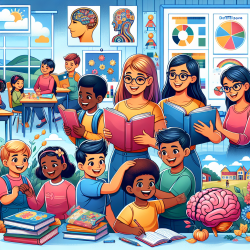Introduction
Prader-Willi Syndrome (PWS) is a complex genetic disorder that presents unique challenges in the field of speech-language pathology. Recent research, particularly the study "Prader–Willi Syndrome and Chromosome 15q11.2 BP1-BP2 Region: A Review," provides valuable insights into the genetic underpinnings of PWS and their implications for clinical practice. Understanding these genetic factors can enhance therapeutic outcomes for children with PWS.
Genetic Insights and Clinical Implications
The study highlights the significance of the 15q11.2 BP1-BP2 region, which contains four key genes: NIPA1, NIPA2, CYFIP1, and TUBGCP5. These genes play critical roles in brain and muscle development, neurobehavioral outcomes, and metabolic processes. The deletion of this region, often seen in PWS, is associated with more severe neurodevelopmental symptoms, including speech and motor delays, and behavioral issues.
For speech-language pathologists, understanding the genetic basis of these symptoms can inform more targeted interventions. For instance, recognizing the role of magnesium transporters encoded by NIPA1 and NIPA2 in brain function can lead to considerations of dietary and nutritional interventions alongside traditional therapy.
Practical Applications for Speech-Language Pathologists
- Targeted Interventions: Tailor therapy to address specific neurodevelopmental challenges associated with the 15q11.2 BP1-BP2 deletion.
- Interdisciplinary Collaboration: Work closely with geneticists and nutritionists to address the metabolic and nutritional needs of children with PWS.
- Early Diagnosis and Intervention: Advocate for early genetic testing to identify children at risk and begin intervention as soon as possible to improve outcomes.
Encouraging Further Research
While the current study provides a robust foundation, ongoing research is essential to fully understand the implications of the 15q11.2 BP1-BP2 region. Speech-language pathologists are encouraged to stay informed about the latest genetic research and consider participating in interdisciplinary studies that explore new therapeutic approaches.
Conclusion
The intersection of genetics and speech-language pathology offers promising avenues for improving the lives of children with Prader-Willi Syndrome. By integrating genetic insights into clinical practice, practitioners can enhance their therapeutic strategies and ultimately contribute to better developmental outcomes.
To read the original research paper, please follow this link: Prader–Willi Syndrome and Chromosome 15q11.2 BP1-BP2 Region: A Review.










